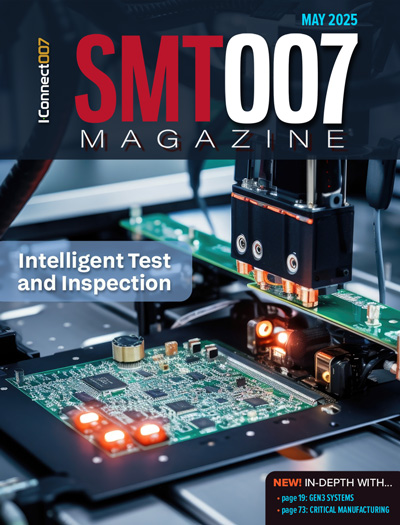-

- News
- Books
Featured Books
- smt007 Magazine
Latest Issues
Current Issue
What's Your Sweet Spot?
Are you in a niche that’s growing or shrinking? Is it time to reassess and refocus? We spotlight companies thriving by redefining or reinforcing their niche. What are their insights?

Moving Forward With Confidence
In this issue, we focus on sales and quoting, workforce training, new IPC leadership in the U.S. and Canada, the effects of tariffs, CFX standards, and much more—all designed to provide perspective as you move through the cloud bank of today's shifting economic market.

Intelligent Test and Inspection
Are you ready to explore the cutting-edge advancements shaping the electronics manufacturing industry? The May 2025 issue of SMT007 Magazine is packed with insights, innovations, and expert perspectives that you won’t want to miss.
- Articles
- Columns
- Links
- Media kit
||| MENU - smt007 Magazine
ECT’s LFRE Plating Extends Probe Life and Time Between Cleaning Cycles
November 3, 2015 | Everett Charles TechnologiesEstimated reading time: 2 minutes
Everett Charles Technologies (ECT) has proven the exceptional performance of LFRE spring probe products in a challenging evaluation at a major automotive electronics supplier with global manufacturing facilities. The ECT LFRE probes, which were used in an in-circuit test fixture, tripled insertion life and reduced cleaning frequency by a factor of 10 compared to the original set up.
ECT LFRE probes meet the challenges of lead free pads. Lead free solder has a higher reflow temperature, which can result in harder and stickier solder flux resin and a thicker, harder oxide layer. This thicker layer of resin and oxide is more difficult to penetrate and increases wear on the pogo pin. Lead free solder resin and oxides can also increase debris transfer to spring probes. These are many of the issues found in OSP (Organic Solderability Preservatives) and no-clean applications.
ECT’s proprietary LFRE plated probes have two key attributes that make it an ideal choice for the most challenging PCB test applications. LFRE provides a smooth, slick plating surface that not only resists wear but also resists solder and debris transfer. ECT’s LFRE plating is also significantly harder than the industry’s standard gold plating and has a hardness range of 550 to 650 Knoop. This makes the probe tips much more durable and less susceptible to solder and material transfer. LFRE probes incorporate a double roll close, which offers the industry’s best pointing accuracy. Increased pointing accuracy is of benefit when using lead free solder and/or no-clean as the probe is less likely to touch the edge of the pad where the solder flux accumulates.
Tony DeRosa, Product Manager, highlights: “The customer was experiencing excessive cleaning, short probe life, and low first pass yield. Contamination due to excessive solder flux was limiting probe life to only 60k insertions. We were able to improve insertion life to more than 180k cycles and to reduce the cleaning frequency to 2-3 times per week.”
LFRE plated probes leverage ECT’s long-term expertise in materials and platings along with probe fabrication knowledge. The LFLT probe - the long travel version of the LFRE probe - incorporates ECT’s proven PogoPlus bias ball design and double roll close process. Both of which contribute to making sustainable and reliable contact to PCB targets.
LFRE Pogo pins are available in a variety of spring force choices and pitches. All of ECT’s lead free (LFRE) probes have a spring fatigue life that surpasses 500,000 cycles.
About Everett Charles Technologies (ECT)
ECT (headquartered in Fontana, CA) is the world's leading manufacturer of POGO ® contact probes for a wide range of applications including industrial, medical, military, connectors and testing bare and loaded printed circuit boards. R&D programs address engineering and materials issues that will affect Contact Solutions for the next decade. Methods for maintaining electrical continuity in miniature probes, improved spring technologies, and probe head geometries are under continual review. ECT POGO ® contacts are marketed worldwide through sales offices in the United States, Europe and Asia. ECT is a company of Xcerra™ Corporation, which provides capital equipment, interface products, and services to the semiconductor, industrial, and electronics manufacturing industries. Xcerra Corporation offers a comprehensive portfolio of solutions and technologies, and a global network of strategically deployed applications and support resources.
Suggested Items
Driving Innovation: Direct Imaging vs. Conventional Exposure
07/01/2025 | Simon Khesin -- Column: Driving InnovationMy first camera used Kodak film. I even experimented with developing photos in the bathroom, though I usually dropped the film off at a Kodak center and received the prints two weeks later, only to discover that some images were out of focus or poorly framed. Today, every smartphone contains a high-quality camera capable of producing stunning images instantly.
Hands-On Demos Now Available for Apollo Seiko’s EF and AF Selective Soldering Lines
06/30/2025 | Apollo SeikoApollo Seiko, a leading innovator in soldering technology, is excited to spotlight its expanded lineup of EF and AF Series Selective Soldering Systems, now available for live demonstrations in its newly dedicated demo room.
Indium Corporation Expert to Present on Automotive and Industrial Solder Bonding Solutions at Global Electronics Association Workshop
06/26/2025 | IndiumIndium Corporation Principal Engineer, Advanced Materials, Andy Mackie, Ph.D., MSc, will deliver a technical presentation on innovative solder bonding solutions for automotive and industrial applications at the Global Electronics A
Fresh PCB Concepts: Assembly Challenges with Micro Components and Standard Solder Mask Practices
06/26/2025 | Team NCAB -- Column: Fresh PCB ConceptsMicro components have redefined what is possible in PCB design. With package sizes like 01005 and 0201 becoming more common in high-density layouts, designers are now expected to pack more performance into smaller spaces than ever before. While these advancements support miniaturization and functionality, they introduce new assembly challenges, particularly with traditional solder mask and legend application processes.
Knocking Down the Bone Pile: Tin Whisker Mitigation in Aerospace Applications, Part 3
06/25/2025 | Nash Bell -- Column: Knocking Down the Bone PileTin whiskers are slender, hair-like metallic growths that can develop on the surface of tin-plated electronic components. Typically measuring a few micrometers in diameter and growing several millimeters in length, they form through an electrochemical process influenced by environmental factors such as temperature variations, mechanical or compressive stress, and the aging of solder alloys.


